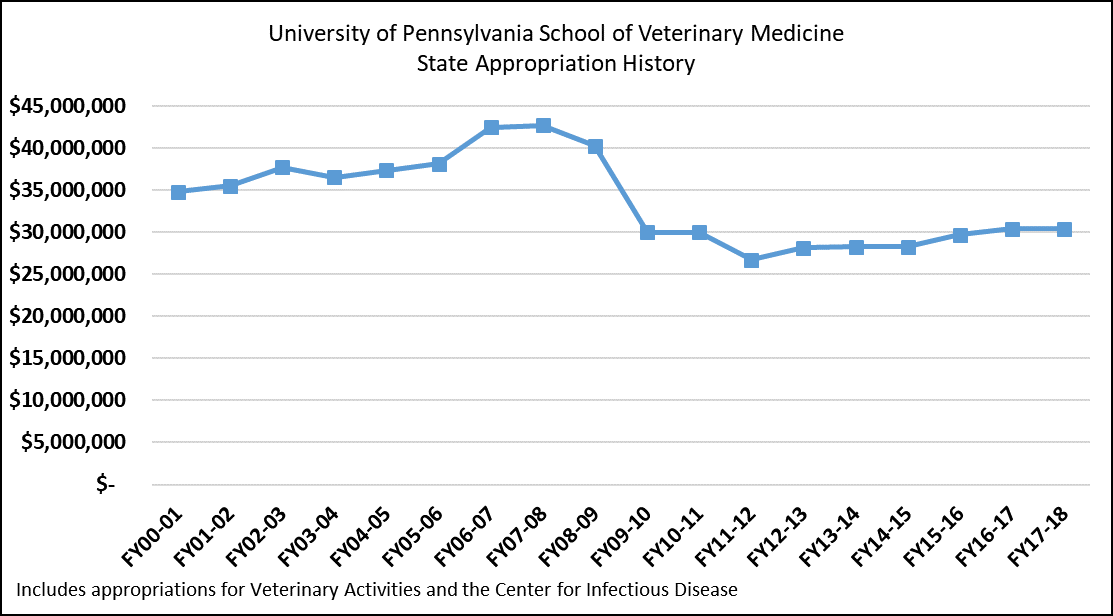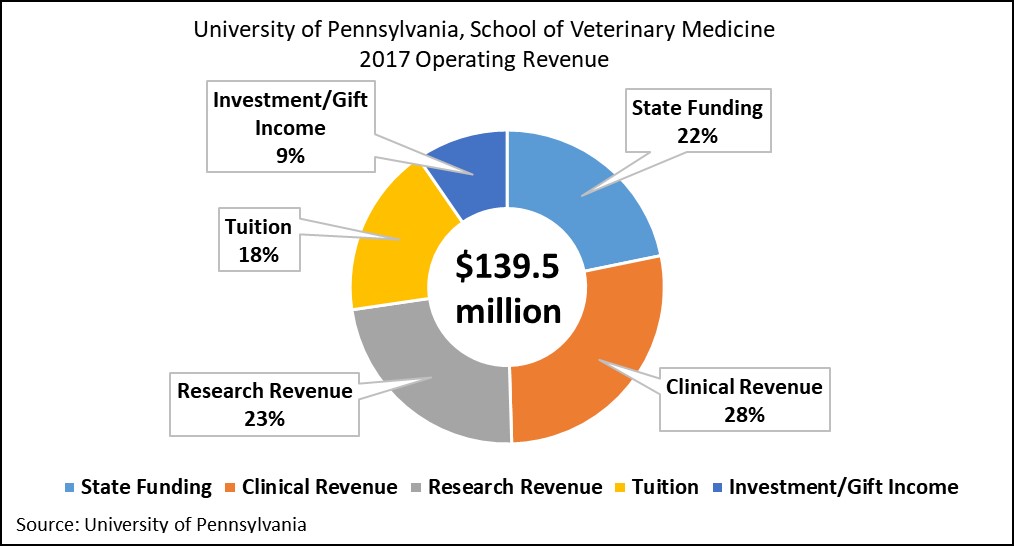University of Pennsylvania School of Veterinary Medicine: Primer
By Mike Passiment , | 8 years ago
Agriculture Analyst: Gueorgui Tochev, Senior Budget Analyst
The School of Veterinary Medicine at the University of Pennsylvania has served as one of the world’s premier veterinary schools for 133 years. The Philadelphia-based school has educated generations of veterinarians, developed breakthrough technology to monitor and control infectious disease, and pioneered research in germ cell biology, comparative oncology, immunology, and comparative medical genetics.
The veterinary school, known as Penn Vet, has also maintained a unique role in Pennsylvania. In addition to serving as the sole veterinary school in the commonwealth, Penn Vet has been an unwavering partner in service to agriculture. From education and research to service in agriculture and employment in the commonwealth, Penn Vet has been a significant economic asset for Pennsylvania. This primer is an overview and history of the school, its relationship with the commonwealth, and its wide-ranging impact in Pennsylvania.
History
As a concept, the School of Veterinary Medicine at the University of Pennsylvania dates back to 1807. Benjamin Rush, a professor at the University of Pennsylvania’s medical school, proposed adding veterinary medicine to the school’s offerings. However, his idea did not evolve into a realistic venture until 1882, when a university trustee donated $10,000 to establish the veterinary school. Officially founded in 1884, the institution is the only veterinary school in the country developed in association with a medical school.
In its earliest days, Penn’s veterinary school was considered to be a worthwhile investment. In 1889, the state legislature appropriated $25,000 for the vet school. Adjusted for inflation, this appropriation would have been the equivalent of $673,000 in 2017.
Thanks to generous benefactors, the veterinary school grew in size and influence. In 1913, it opened a building that is still being used today. In 1937, four years after offering admission to women, the school established an ambulatory clinic for students interested in a unique, hands-on learning experience with horses, cattle, pigs, goats, and other large farm animals.
In 1952, the veterinary school opened the New Bolton Center in Chester County to serve as a major base for teaching, research and clinical services in veterinary medicine. 12 years later, the New Bolton Center opened the Hospital for Large Animals, which became internationally renowned for the quality of care provided for animals. It now boasts one of the largest caseloads of any academic large animal hospital in the country.
Education and Research
Penn Vet offers its students a comprehensive education through a rigorous curriculum, complete with learning opportunities at its urban and rural campuses. The Ryan Hospital in Philadelphia cares for companion animals and less common mammals and exotic animals, while the New Bolton Center is the nation’s foremost large animal hospital.
Central to this education, and critical to the agricultural community, is Penn Vet’s “One Health” focus, linking human, animal, and environmental health.
Because of the school’s unique origins in association with a medical school, graduates receive the veterinariae medicinae doctoris (VMD) upon completion of their studies. Penn Vet is the only school in the country that confers this degree. Students can also choose to complete a dual VMD-PhD degree, or a VMD-MBA degree. The VMD-PhD is tailored to students seeking to do long-term research, while the VMD-MBA is suited for students seeking to address stark challenges in agriculture, climate change, inequality, or land and water shortages.
To fulfill its partnership with the commonwealth, Penn Vet offers incentives and admission preferences to Pennsylvania residents. The school lowered tuition in 2016 by $10,000 for 168 students from Pennsylvania, providing considerable debt relief to students. Nearly 40 percent of the Penn Vet student body are in-state residents.
According to alumni data, 75 percent of practicing veterinarians in Pennsylvania graduated from Penn Vet. These alumni reside and practice in 65 of Pennsylvania’s 67 counties, as shown in the map below.

Source: University of Pennsylvania
Penn Vet is consistently a top-ranked school in national and international rankings. For example, in the 2016 QS World University Rankings, Penn Vet ranked 4th in the world. It also boasts top-ranking status in animals and products in Mid-Atlantic/New England states.
Penn Vet’s students and faculty have also been on the cutting edge of veterinary research. According to the school, its researchers secured more than $19 million in federal funding for projects in 2016, bringing groundbreaking advances in a range of scientific fields. Furthermore, Penn Vet is reporting $32.3 million in research revenue for 2017, and 233 research projects.
Penn Vet operates a plethora of research centers, focusing on infectious disease, regenerative medicine, neuroscience, health and productivity in food animal herds and flocks, and comparative oncology. Some of the research centers include:
· Center for Animal Health & Productivity
· Center for Interaction of Animals & Society
· Penn Vet Working Dog Center
· Swine Teaching and Research Center
· Veterinary Clinical Investigations Center
Partnership with the Commonwealth and Community Service
Penn Vet and the Commonwealth of Pennsylvania have had a unique and productive working partnership since the school’s founding in 1884, and the first state appropriation in 1889. Penn Vet plays a central role in promoting agricultural production and community health.
· The Laboratory of Avian Medicine and Pathology regularly tests for avian influenza to help protect Pennsylvania’s food supply. This was particularly noteworthy in 2015 when there was a seriously elevated risk of flocks contracting the highly pathogenic virus.
· The Marshak Dairy provides students with hands-on training and serves as a research farm to address critical issues facing the dairy industry in Pennsylvania.
· Work conducted at the Swine Teaching and Research Center has led to a 30 percent reduction in swine disease prevalence.
· In its objective to pursue environmental sustainability, Penn Vet has helped the agricultural community establish best agricultural practices to curb runoff and non-point source pollution in the state’s 19,000 miles of impaired streams, thereby reducing Pennsylvania’s Chesapeake Bay cleanup costs.
In one of its most effective partnerships, Penn Vet is one actor in the tripartite Pennsylvania Animal Diagnostic Laboratory System. Made up of the Pennsylvania Veterinary Laboratory in Harrisburg, Penn State University’s Animal Diagnostic Laboratory, and the University of Pennsylvania’s New Bolton Center, this collaboration is key to continued strength in Pennsylvania agriculture. The diagnostic lab combines the regulatory authority of the state Department of Agriculture with the agricultural and veterinary expertise of Penn State and the University of Pennsylvania.
Penn Vet also operates the Equine Toxicology and Research Laboratory, which is the only facility in the commonwealth equipped to perform the drug testing required for horse racing. The New Bolton Center processes 31,000 test samples every year to support the horse racing industry, which generates about $1.6 billion in economic activity.
State Appropriations for Penn Vet
As previously noted, the General Assembly began supporting the veterinary school in 1889. The chart at the top of page 4 tracks state appropriations to Penn Vet since 2000. Over the past 17 years $576.8 million has been appropriated to the commonwealth’s sole veterinary school. Notable, however, is the relative funding decline in recent years. The state appropriation for veterinary activities and the Center for Infectious Disease at the University of Pennsylvania has dropped 29 percent since 2007/08.
Most recently, the University of Pennsylvania received $30.4 million in 2016/17 for all veterinary activities, which represented roughly 22 percent of Penn Vet’s operating revenue. The remaining dollars are generated by clinical revenue, tuition, revenue from research projects, and various gifts to the school.


The state’s support of Penn Vet is not provided in the General Appropriations Act, as it is a non-preferred appropriation. Non-preferred appropriations go to charitable or educational institutions not under the absolute control of the commonwealth, and they must be made in a separate legislative bill, and carry the affirmative vote of two-thirds of both the House and Senate.
For the first time in recent memory, due to an unusually difficult budget, the governor proposed eliminating 2017/18 funding for the vet school, but ultimately policymakers agreed to maintain the appropriation at the prior year amount.
Click here to download the document.